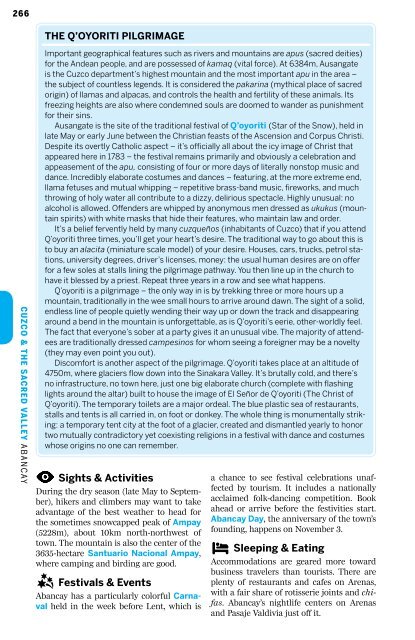peru-8-cuzco-sacred-valley
You also want an ePaper? Increase the reach of your titles
YUMPU automatically turns print PDFs into web optimized ePapers that Google loves.
266<br />
THE Q’OYORITI PILGRIMAGE<br />
Cuzco & the Sacred Valley C S A I B u G A zC H N T O C S AY TO & AC T H T E I V C I E T N I E T S R A L H I G H L A N D S<br />
Important geographical features such as rivers and mountains are apus (<strong>sacred</strong> deities)<br />
for the Andean people, and are possessed of kamaq (vital force). At 6384m, Ausangate<br />
is the Cuzco department’s highest mountain and the most important apu in the area –<br />
the subject of countless legends. It is considered the pakarina (mythical place of <strong>sacred</strong><br />
origin) of llamas and alpacas, and controls the health and fertility of these animals. Its<br />
freezing heights are also where condemned souls are doomed to wander as punishment<br />
for their sins.<br />
Ausangate is the site of the traditional festival of Q’oyoriti (Star of the Snow), held in<br />
late May or early June between the Christian feasts of the Ascension and Corpus Christi.<br />
Despite its overtly Catholic aspect – it’s officially all about the icy image of Christ that<br />
appeared here in 1783 – the festival remains primarily and obviously a celebration and<br />
appeasement of the apu, consisting of four or more days of literally nonstop music and<br />
dance. Incredibly elaborate costumes and dances – featuring, at the more extreme end,<br />
llama fetuses and mutual whipping – repetitive brass-band music, fireworks, and much<br />
throwing of holy water all contribute to a dizzy, delirious spectacle. Highly unusual: no<br />
alcohol is allowed. Offenders are whipped by anonymous men dressed as ukukus (mountain<br />
spirits) with white masks that hide their features, who maintain law and order.<br />
It’s a belief fervently held by many cuzqueños (inhabitants of Cuzco) that if you attend<br />
Q’oyoriti three times, you’ll get your heart’s desire. The traditional way to go about this is<br />
to buy an alacita (miniature scale model) of your desire. Houses, cars, trucks, petrol stations,<br />
university degrees, driver’s licenses, money: the usual human desires are on offer<br />
for a few soles at stalls lining the pilgrimage pathway. You then line up in the church to<br />
have it blessed by a priest. Repeat three years in a row and see what happens.<br />
Q’oyoriti is a pilgrimage – the only way in is by trekking three or more hours up a<br />
mountain, traditionally in the wee small hours to arrive around dawn. The sight of a solid,<br />
endless line of people quietly wending their way up or down the track and disappearing<br />
around a bend in the mountain is unforgettable, as is Q’oyoriti’s eerie, other-worldly feel.<br />
The fact that everyone’s sober at a party gives it an unusual vibe. The majority of attendees<br />
are traditionally dressed campesinos for whom seeing a foreigner may be a novelty<br />
(they may even point you out).<br />
Discomfort is another aspect of the pilgrimage. Q’oyoriti takes place at an altitude of<br />
4750m, where glaciers flow down into the Sinakara Valley. It’s brutally cold, and there’s<br />
no infrastructure, no town here, just one big elaborate church (complete with flashing<br />
lights around the altar) built to house the image of El Señor de Q’oyoriti (The Christ of<br />
Q’oyoriti). The temporary toilets are a major ordeal. The blue plastic sea of restaurants,<br />
stalls and tents is all carried in, on foot or donkey. The whole thing is monumentally striking:<br />
a temporary tent city at the foot of a glacier, created and dismantled yearly to honor<br />
two mutually contradictory yet coexisting religions in a festival with dance and costumes<br />
whose origins no one can remember.<br />
1 Sights & Activities<br />
During the dry season (late May to September),<br />
hikers and climbers may want to take<br />
advantage of the best weather to head for<br />
the sometimes snowcapped peak of Ampay<br />
(5228m), about 10km north-northwest of<br />
town. The mountain is also the center of the<br />
3635-hectare Santuario Nacional Ampay,<br />
where camping and birding are good.<br />
z Festivals & Events<br />
Abancay has a particularly colorful Carnaval<br />
held in the week before Lent, which is<br />
a chance to see festival celebrations unaffected<br />
by tourism. It includes a nationally<br />
acclaimed folk-dancing competition. Book<br />
ahead or arrive before the festivities start.<br />
Abancay Day, the anniversary of the town’s<br />
founding, happens on November 3.<br />
4 Sleeping & Eating<br />
Accommodations are geared more toward<br />
business travelers than tourists. There are<br />
plenty of restaurants and cafes on Arenas,<br />
with a fair share of rotisserie joints and chifas.<br />
Abancay’s nightlife centers on Arenas<br />
and Pasaje Valdivia just off it.


